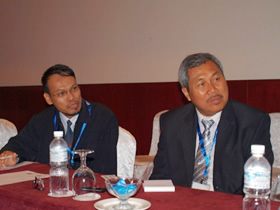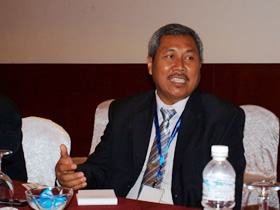Interview with Mr. Suhermanto S, Director, Satellite Technology Center, National Institute of Aeronautics and Space (LAPAN), Indonesia, at APRSAF-19 in Kuala Lumpur (Dec 2012)
The APRSAF Secretariat interviewed Mr. Suhermanto S, Director, Satellite Technology Center, National Institute of Aeronautics and Space (LAPAN), Indonesia, at APRSAF-19 in Kuala Lumpur, Malaysia, in December 2012. He mainly talked about LAPAN's Automatic Identification System (AIS), or ship monitoring system, whose equipment will be carried on LAPAN's next satellite, LAPAN-A2. The AIS was one of the main topics at the APRSAF-19 Communication Satellite Applications Working Group (CSA WG).
Secretariat: Why did LAPAN decide to put an AIS payload on its next satellite, LAPAN-A2?

S: I heard the satellite itself will be built by LAPAN. What about the AIS payload?
We will simply integrate the subsystems. Regarding LAPAN-A2, we will focus on design and assembly, integration, and testing. Most of the components are not made by LAPAN. Sometimes we obtain them from a partner in another country. For example, we cooperate with our Norwegian partner, Kongsberg, which is known for space-borne AISs, AISSat-1 and NORAIS.
S: Within Indonesia, how do you cooperate with other governmental entities to make use of AIS?

Presently, in Indonesia, several institutions exist that have the authority to monitor Indonesian waters. Our government wants to integrate all systems with an AIS into a single surveillance system. The government is currently working to use coastal radars, AISs, and satellite data to create a network system for water territory monitoring. If we launch our satellite by 2013, we will be able to contribute to this system.
S: Do private shipping companies use AIS data?
Yes. Our responsibility at the moment is to submit the data to the Maritime Authority, which decides how to use the data. We will cooperate with it in developing the AIS system, and after the launch of the satellite, we intend to study how to use it together.
S: What about ground stations? Have they been developed by LAPAN or the Maritime Authority?
Right now, LAPAN has five ground station networks. We have decided which one should manage the AIS data, and a system to facilitate this has been set up. From this ground station, we will obtain relevant data and submit it to the Maritime Authority.
S: Do you have any plans for the future?

LAPAN-A3 is next on our agenda. The main mission of LAPAN-A3 is an imagery experiment involving earth observation. We intend to use our AIS for this mission so that we can obtain global coverage of AIS data. By combining these two types of data, we will obtain more valuable information on maritime traffic.
LAPAN-A2 and LAPAN-A3 are for technological demonstration purposes only. It is important to note this, because sometimes, the Maritime Authority decides to make a satellite fully operational. However, because LAPAN has limited opportunities to launch its satellites and conduct experiments with them, one satellite has to be used for many missions; so, having a fully operational satellite is not quite practical.
Next on our agenda are LAPAN-A4 and A5, which will be next-generation satellites. LAPAN-A4's mission will involve the validation of optical images. We also intend to develop a synthetic aperture radar (SAR).
Our missions involving the satellites tend to be piggyback ones owing to budget and facility constraints; microsatellites are quite suited to such missions. So, for LAPAN-A4 and A5, we intend to develop microsatellite class, and they would not be an experimental but fully operational satellite. We call them "transition" between experimental to fully operational. We intend to build a fully operational satellite, because we want our country to receive the full benefit of our research.
S: I see. Incidentally, what are your impressions of the APRSAF meeting?
I believe that APRSAF, we can discuss the progress and status of the development of our satellites with everyone. Also, it is a good place to obtain advice on our activities.
At APRSAF, information can be shared not only between governments or space agencies but also from governments to space agencies or the other way around. We also have information on the availability of products. We are likely to find solutions to our problems at APRSAF, because sometimes, problems similar to ours tend to have already been solved by other companies or institutions.
S: Especially within the working group, the CSA working group?
Yes. For APRSAF-19, we have a special topic pertaining to the AIS, and discussions on this topic are likely to be a learning experience. For instance, what we have done in Indonesia has been done in Japan as well, so perhaps Japan may have a solution to, for example, AIS data management problems. We are looking forward to a collaborative learning experience and to cooperation in the near future.
S: Thank you.